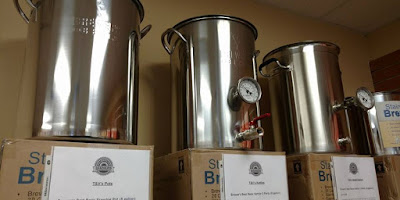How do you know what Wine you like?
You know sometimes it's helpful to take a step back from what we are doing and look at things from the beginner's point of view. We are always talking about winemaking, wine kits, new products, and the next "batch". But for someone who is new to the winemaking, or possibly even the wine drinking world, we figured a few simple thoughts on "where to get your feet wet" may help. The more you make what you like, the more fun you will have.
There are hundreds of types of both red and white wine grapes (called varietals) contributing to their diversity. But to keep it simple, there are some general categories to consider for the next time you’re thinking of making and drinking wine. Plus we put up a cool picture above to help you with the sliding scale of "Major Reds & Whites":-)
So here we go with some basics across the board:
Sparkling – Sparkling wine ranges from very dry to very sweet, and generally contains less alcohol than other table wines. You’ll usually find that sparkling wine is either white or rosé. Interesting note: only sparkling wine produced in Champagne, France is technically given the title of Champagne.
- Pair with: Poultry or seafood, a creamy sauce, cheese, or enjoy on its own.
- When to serve: Celebrations and parties
White – With white wine, grapes are separated from their skins and made into juice before fermentation. They’re not all light wines. They can be light-, medium- or full-bodied, which represents how thick they feel in your mouth. Sweet wines like Riesling tend to be on the lighter (thinner) end while Chardonnay is at the fuller end, with a higher alcohol content, and a rich, creamy flavor.
- Pair with: Fish, salads, and meals with sour flavors like lemon, as well as desserts.
- When to serve: Light whites for summer events, or fall for full-bodied whites
Rosé – If you’re looking for an in-between selection, Rosé is a good option.It is a versatile wine that can be paired with many dishes. It’s typically made from black grapes (red-wine grapes), giving it subtle color. However, like whites, it’s best served soon after its release for optimal flavor and aromas.
- Pair with: Most cheeses, pasta dishes, as well as any spring or summer meal.
- When to serve: Spring and summer events and parties
Red – Red wines have bold, complex flavors, but it’s hard to generalize them because they have so many flavor profiles and aromas. As a rule, most are commonly paired with red meat. When choosing the type you want to pair with your meal, consider the meat (if any) you’ll be serving. The bolder the wine, the richer the meat should be.
- When to serve: Great year-round, but should be your go-to for fall and winter dinner parties and gatherings.
- Pair with: A main course that includes red meats, strong cheeses or salty foods
Dessert – Made from naturally sweet grapes, these wines are the sweetest. These always taste delicious alongside fruit, chocolate and other desserts. Keep in mind that you want to serve one that’s sweeter than the dessert, so the food doesn’t take away or change the wine’s flavor.
- When to serve: After the main course in any meal
- Pair with: Other desserts, or salty foods
WINE SELECTING TIPS
The key to successful wine selection is developing your palate. The most basic way to start is to begin with what you smell and taste – from there, you’ll unearth the many aromas and flavors that go into a single sip. Wine can have aromas ranging from fruit to herbs to smoky scents, and over time you’ll pick up on the different hints of each.
Hope this helps orient a few beginners out these in "wineworld". And please, always feel free to call us or email us anytime, we are pleased to help.
T&V







